Analysis of Apple's Outsourcing and Vertical Integration Strategies
VerifiedAdded on 2021/11/16
|6
|1239
|523
Report
AI Summary
This report provides a comprehensive analysis of Apple Inc.'s outsourcing and vertical integration strategies, focusing on its global expansion, particularly in the electronics sector. It begins with a SWOT analysis, highlighting Apple's strengths, such as its market dominance and cost-effective strategies, and weaknesses, including over-reliance on the Chinese market and intellectual property challenges. The report examines the advantages and disadvantages of Apple's offshore operations, the factors influencing its choice of countries, and the challenges faced by Microsoft in competing with Apple. It also addresses the impact on the American workforce and the importance of vertical integration. The report offers recommendations to both Apple and Microsoft, suggesting strategies to enhance market capabilities and explore alternative labor forces. The analysis is supported by references to academic literature and case studies.
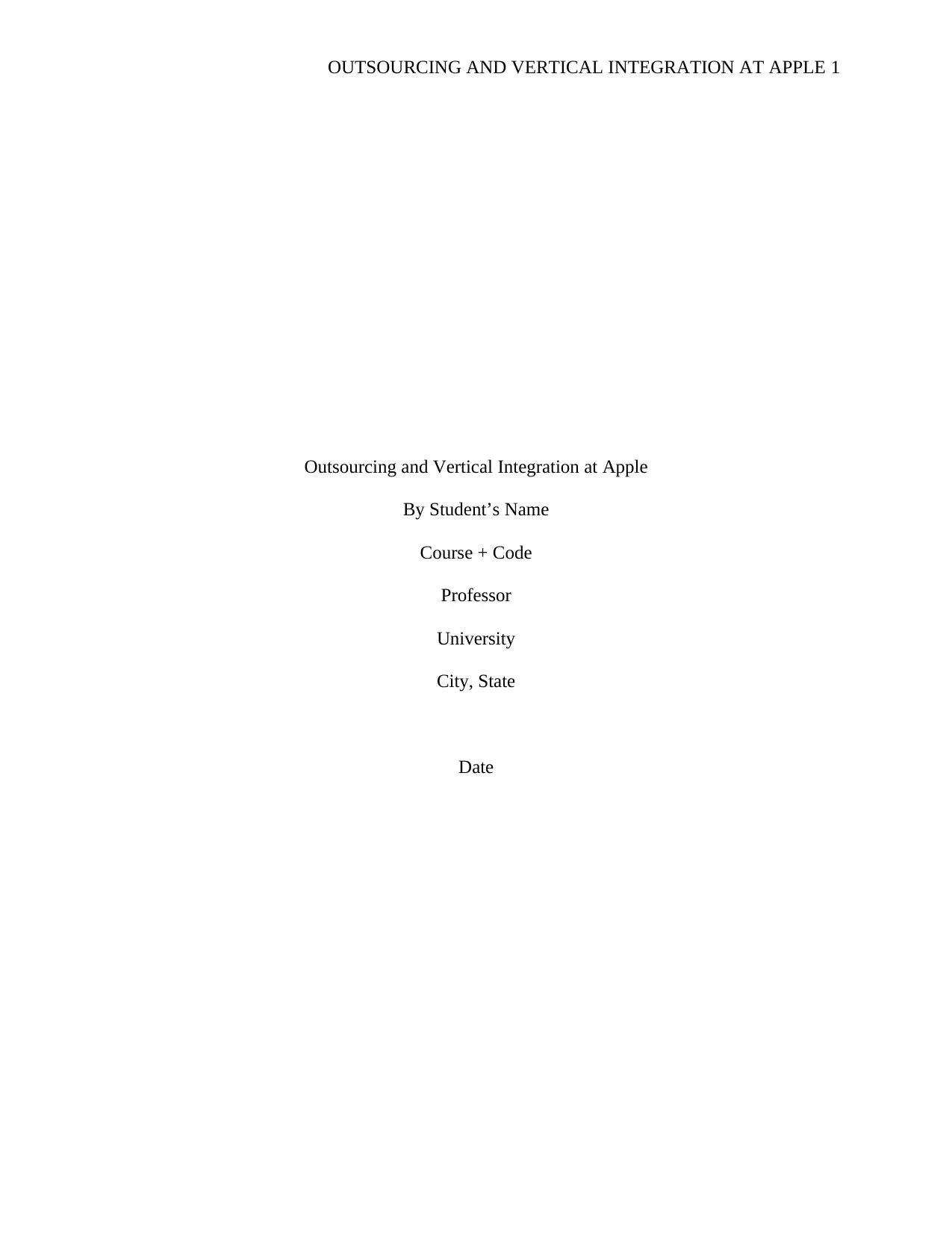
OUTSOURCING AND VERTICAL INTEGRATION AT APPLE 1
Outsourcing and Vertical Integration at Apple
By Student’s Name
Course + Code
Professor
University
City, State
Date
Outsourcing and Vertical Integration at Apple
By Student’s Name
Course + Code
Professor
University
City, State
Date
Paraphrase This Document
Need a fresh take? Get an instant paraphrase of this document with our AI Paraphraser
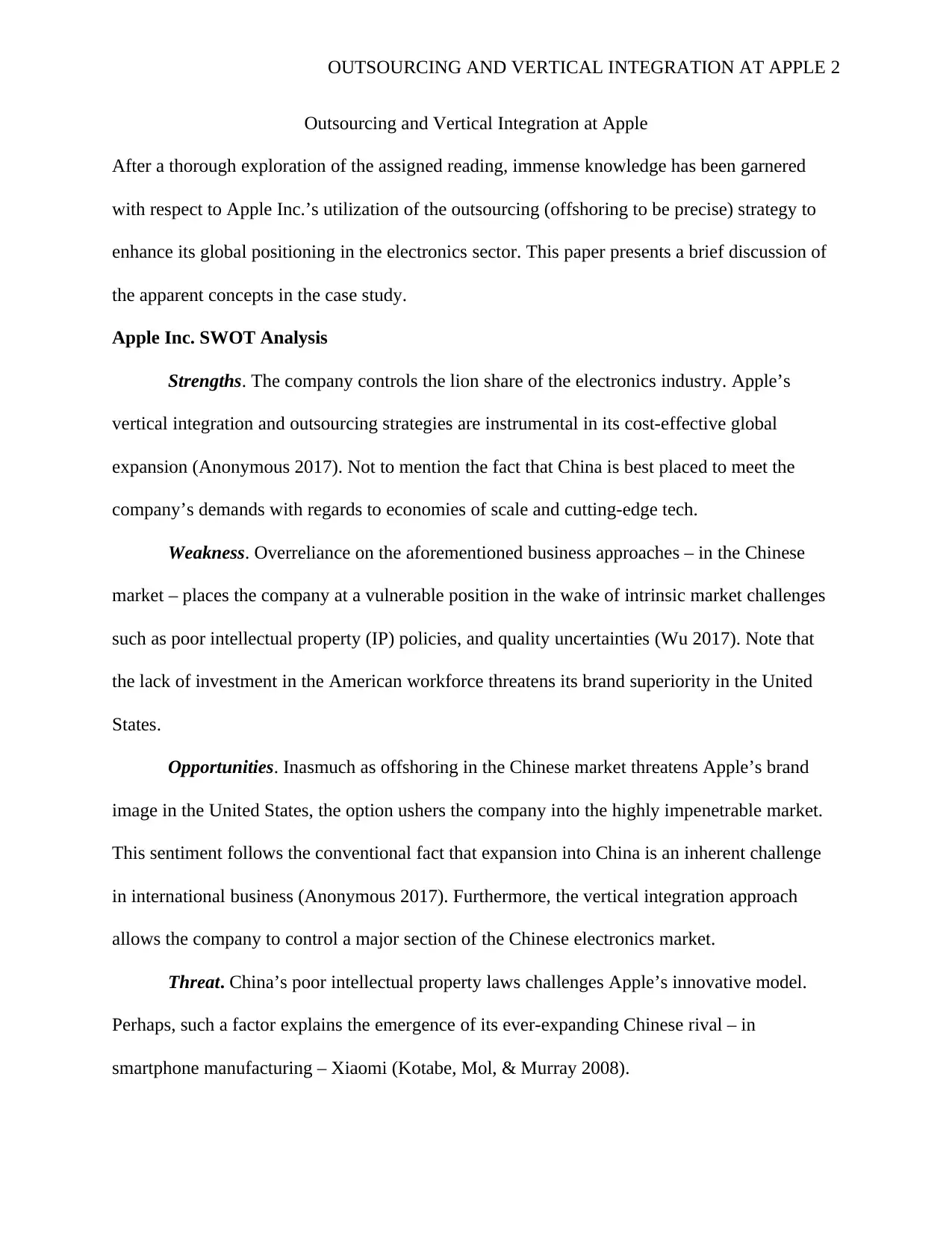
OUTSOURCING AND VERTICAL INTEGRATION AT APPLE 2
Outsourcing and Vertical Integration at Apple
After a thorough exploration of the assigned reading, immense knowledge has been garnered
with respect to Apple Inc.’s utilization of the outsourcing (offshoring to be precise) strategy to
enhance its global positioning in the electronics sector. This paper presents a brief discussion of
the apparent concepts in the case study.
Apple Inc. SWOT Analysis
Strengths. The company controls the lion share of the electronics industry. Apple’s
vertical integration and outsourcing strategies are instrumental in its cost-effective global
expansion (Anonymous 2017). Not to mention the fact that China is best placed to meet the
company’s demands with regards to economies of scale and cutting-edge tech.
Weakness. Overreliance on the aforementioned business approaches – in the Chinese
market – places the company at a vulnerable position in the wake of intrinsic market challenges
such as poor intellectual property (IP) policies, and quality uncertainties (Wu 2017). Note that
the lack of investment in the American workforce threatens its brand superiority in the United
States.
Opportunities. Inasmuch as offshoring in the Chinese market threatens Apple’s brand
image in the United States, the option ushers the company into the highly impenetrable market.
This sentiment follows the conventional fact that expansion into China is an inherent challenge
in international business (Anonymous 2017). Furthermore, the vertical integration approach
allows the company to control a major section of the Chinese electronics market.
Threat. China’s poor intellectual property laws challenges Apple’s innovative model.
Perhaps, such a factor explains the emergence of its ever-expanding Chinese rival – in
smartphone manufacturing – Xiaomi (Kotabe, Mol, & Murray 2008).
Outsourcing and Vertical Integration at Apple
After a thorough exploration of the assigned reading, immense knowledge has been garnered
with respect to Apple Inc.’s utilization of the outsourcing (offshoring to be precise) strategy to
enhance its global positioning in the electronics sector. This paper presents a brief discussion of
the apparent concepts in the case study.
Apple Inc. SWOT Analysis
Strengths. The company controls the lion share of the electronics industry. Apple’s
vertical integration and outsourcing strategies are instrumental in its cost-effective global
expansion (Anonymous 2017). Not to mention the fact that China is best placed to meet the
company’s demands with regards to economies of scale and cutting-edge tech.
Weakness. Overreliance on the aforementioned business approaches – in the Chinese
market – places the company at a vulnerable position in the wake of intrinsic market challenges
such as poor intellectual property (IP) policies, and quality uncertainties (Wu 2017). Note that
the lack of investment in the American workforce threatens its brand superiority in the United
States.
Opportunities. Inasmuch as offshoring in the Chinese market threatens Apple’s brand
image in the United States, the option ushers the company into the highly impenetrable market.
This sentiment follows the conventional fact that expansion into China is an inherent challenge
in international business (Anonymous 2017). Furthermore, the vertical integration approach
allows the company to control a major section of the Chinese electronics market.
Threat. China’s poor intellectual property laws challenges Apple’s innovative model.
Perhaps, such a factor explains the emergence of its ever-expanding Chinese rival – in
smartphone manufacturing – Xiaomi (Kotabe, Mol, & Murray 2008).
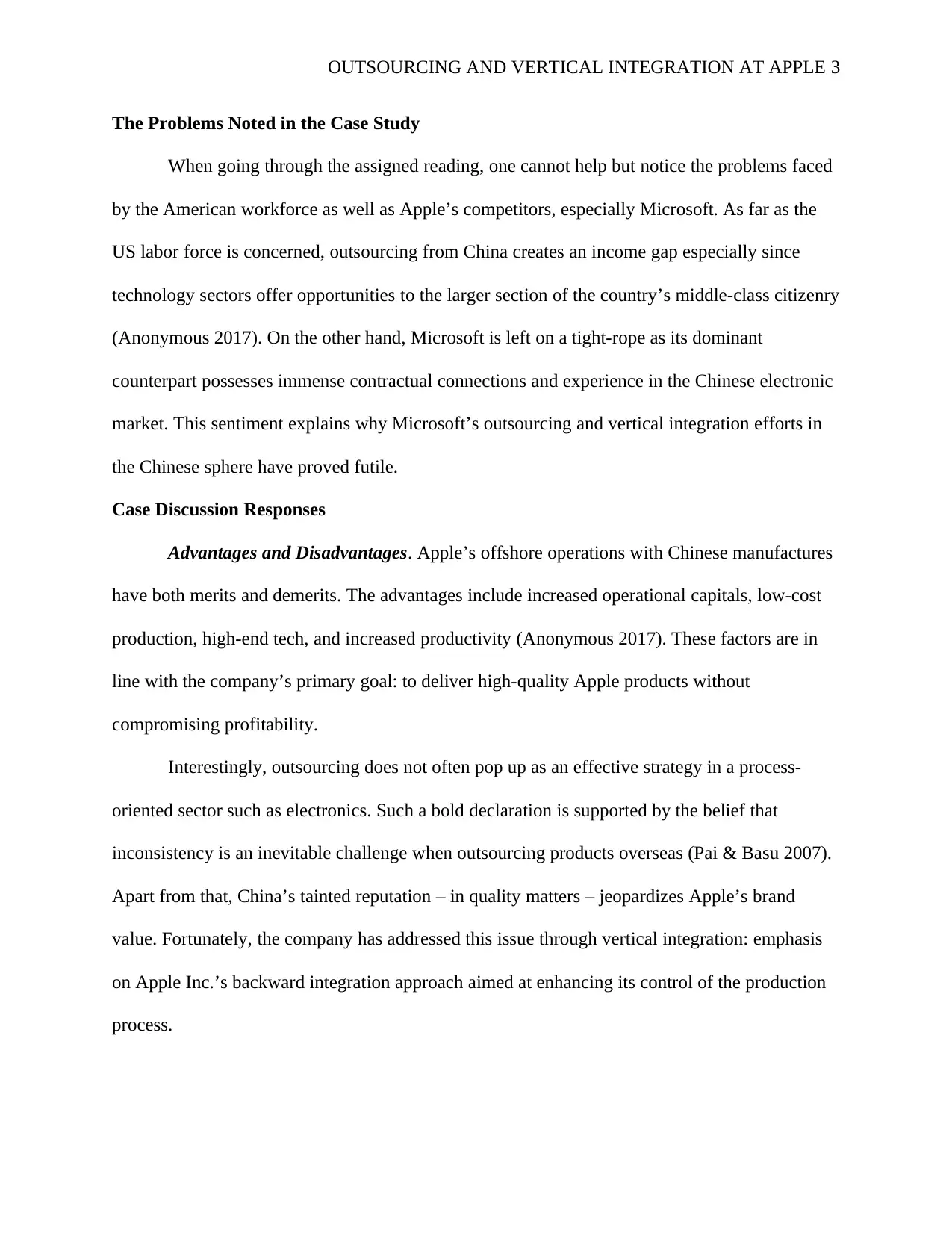
OUTSOURCING AND VERTICAL INTEGRATION AT APPLE 3
The Problems Noted in the Case Study
When going through the assigned reading, one cannot help but notice the problems faced
by the American workforce as well as Apple’s competitors, especially Microsoft. As far as the
US labor force is concerned, outsourcing from China creates an income gap especially since
technology sectors offer opportunities to the larger section of the country’s middle-class citizenry
(Anonymous 2017). On the other hand, Microsoft is left on a tight-rope as its dominant
counterpart possesses immense contractual connections and experience in the Chinese electronic
market. This sentiment explains why Microsoft’s outsourcing and vertical integration efforts in
the Chinese sphere have proved futile.
Case Discussion Responses
Advantages and Disadvantages. Apple’s offshore operations with Chinese manufactures
have both merits and demerits. The advantages include increased operational capitals, low-cost
production, high-end tech, and increased productivity (Anonymous 2017). These factors are in
line with the company’s primary goal: to deliver high-quality Apple products without
compromising profitability.
Interestingly, outsourcing does not often pop up as an effective strategy in a process-
oriented sector such as electronics. Such a bold declaration is supported by the belief that
inconsistency is an inevitable challenge when outsourcing products overseas (Pai & Basu 2007).
Apart from that, China’s tainted reputation – in quality matters – jeopardizes Apple’s brand
value. Fortunately, the company has addressed this issue through vertical integration: emphasis
on Apple Inc.’s backward integration approach aimed at enhancing its control of the production
process.
The Problems Noted in the Case Study
When going through the assigned reading, one cannot help but notice the problems faced
by the American workforce as well as Apple’s competitors, especially Microsoft. As far as the
US labor force is concerned, outsourcing from China creates an income gap especially since
technology sectors offer opportunities to the larger section of the country’s middle-class citizenry
(Anonymous 2017). On the other hand, Microsoft is left on a tight-rope as its dominant
counterpart possesses immense contractual connections and experience in the Chinese electronic
market. This sentiment explains why Microsoft’s outsourcing and vertical integration efforts in
the Chinese sphere have proved futile.
Case Discussion Responses
Advantages and Disadvantages. Apple’s offshore operations with Chinese manufactures
have both merits and demerits. The advantages include increased operational capitals, low-cost
production, high-end tech, and increased productivity (Anonymous 2017). These factors are in
line with the company’s primary goal: to deliver high-quality Apple products without
compromising profitability.
Interestingly, outsourcing does not often pop up as an effective strategy in a process-
oriented sector such as electronics. Such a bold declaration is supported by the belief that
inconsistency is an inevitable challenge when outsourcing products overseas (Pai & Basu 2007).
Apart from that, China’s tainted reputation – in quality matters – jeopardizes Apple’s brand
value. Fortunately, the company has addressed this issue through vertical integration: emphasis
on Apple Inc.’s backward integration approach aimed at enhancing its control of the production
process.
⊘ This is a preview!⊘
Do you want full access?
Subscribe today to unlock all pages.

Trusted by 1+ million students worldwide
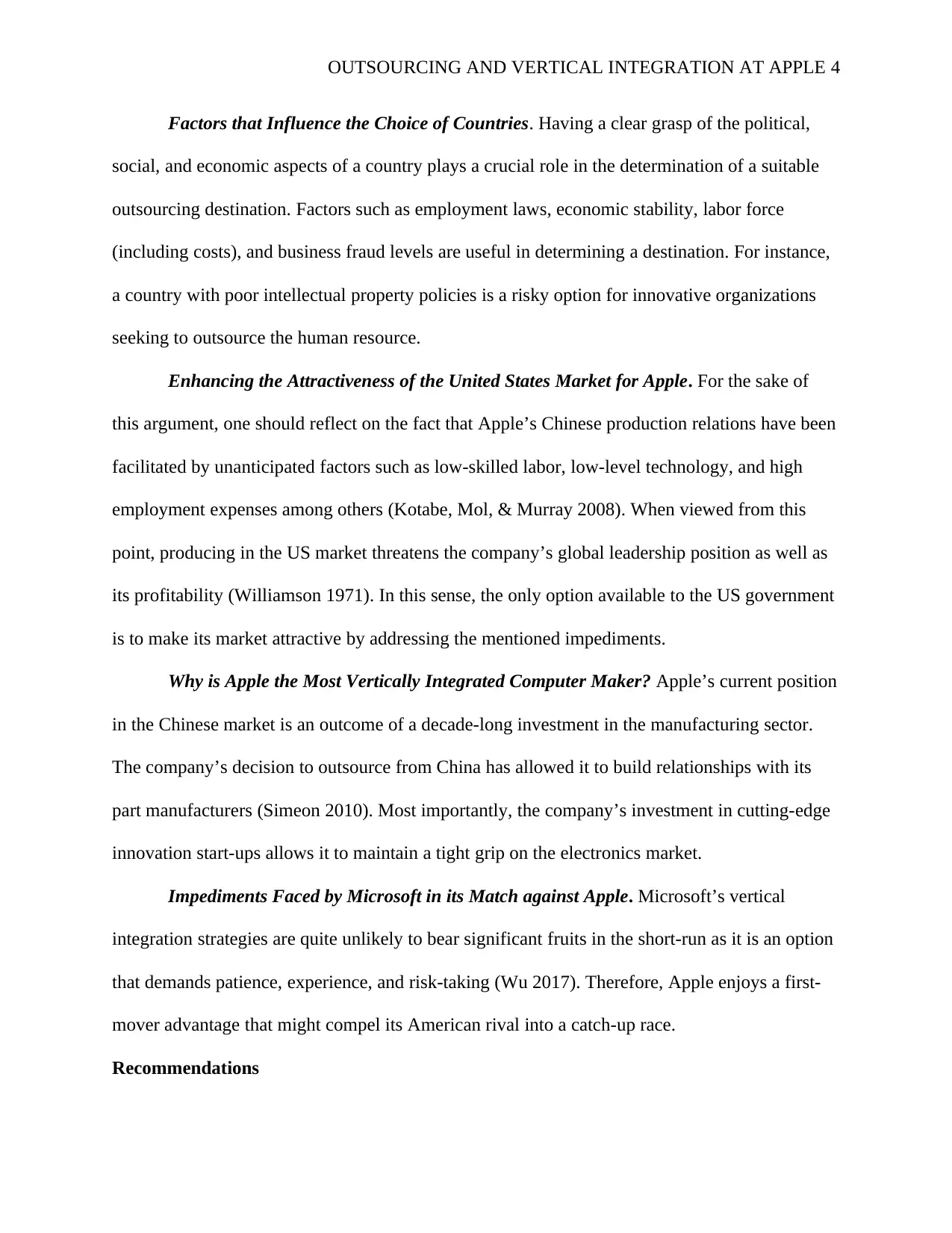
OUTSOURCING AND VERTICAL INTEGRATION AT APPLE 4
Factors that Influence the Choice of Countries. Having a clear grasp of the political,
social, and economic aspects of a country plays a crucial role in the determination of a suitable
outsourcing destination. Factors such as employment laws, economic stability, labor force
(including costs), and business fraud levels are useful in determining a destination. For instance,
a country with poor intellectual property policies is a risky option for innovative organizations
seeking to outsource the human resource.
Enhancing the Attractiveness of the United States Market for Apple. For the sake of
this argument, one should reflect on the fact that Apple’s Chinese production relations have been
facilitated by unanticipated factors such as low-skilled labor, low-level technology, and high
employment expenses among others (Kotabe, Mol, & Murray 2008). When viewed from this
point, producing in the US market threatens the company’s global leadership position as well as
its profitability (Williamson 1971). In this sense, the only option available to the US government
is to make its market attractive by addressing the mentioned impediments.
Why is Apple the Most Vertically Integrated Computer Maker? Apple’s current position
in the Chinese market is an outcome of a decade-long investment in the manufacturing sector.
The company’s decision to outsource from China has allowed it to build relationships with its
part manufacturers (Simeon 2010). Most importantly, the company’s investment in cutting-edge
innovation start-ups allows it to maintain a tight grip on the electronics market.
Impediments Faced by Microsoft in its Match against Apple. Microsoft’s vertical
integration strategies are quite unlikely to bear significant fruits in the short-run as it is an option
that demands patience, experience, and risk-taking (Wu 2017). Therefore, Apple enjoys a first-
mover advantage that might compel its American rival into a catch-up race.
Recommendations
Factors that Influence the Choice of Countries. Having a clear grasp of the political,
social, and economic aspects of a country plays a crucial role in the determination of a suitable
outsourcing destination. Factors such as employment laws, economic stability, labor force
(including costs), and business fraud levels are useful in determining a destination. For instance,
a country with poor intellectual property policies is a risky option for innovative organizations
seeking to outsource the human resource.
Enhancing the Attractiveness of the United States Market for Apple. For the sake of
this argument, one should reflect on the fact that Apple’s Chinese production relations have been
facilitated by unanticipated factors such as low-skilled labor, low-level technology, and high
employment expenses among others (Kotabe, Mol, & Murray 2008). When viewed from this
point, producing in the US market threatens the company’s global leadership position as well as
its profitability (Williamson 1971). In this sense, the only option available to the US government
is to make its market attractive by addressing the mentioned impediments.
Why is Apple the Most Vertically Integrated Computer Maker? Apple’s current position
in the Chinese market is an outcome of a decade-long investment in the manufacturing sector.
The company’s decision to outsource from China has allowed it to build relationships with its
part manufacturers (Simeon 2010). Most importantly, the company’s investment in cutting-edge
innovation start-ups allows it to maintain a tight grip on the electronics market.
Impediments Faced by Microsoft in its Match against Apple. Microsoft’s vertical
integration strategies are quite unlikely to bear significant fruits in the short-run as it is an option
that demands patience, experience, and risk-taking (Wu 2017). Therefore, Apple enjoys a first-
mover advantage that might compel its American rival into a catch-up race.
Recommendations
Paraphrase This Document
Need a fresh take? Get an instant paraphrase of this document with our AI Paraphraser
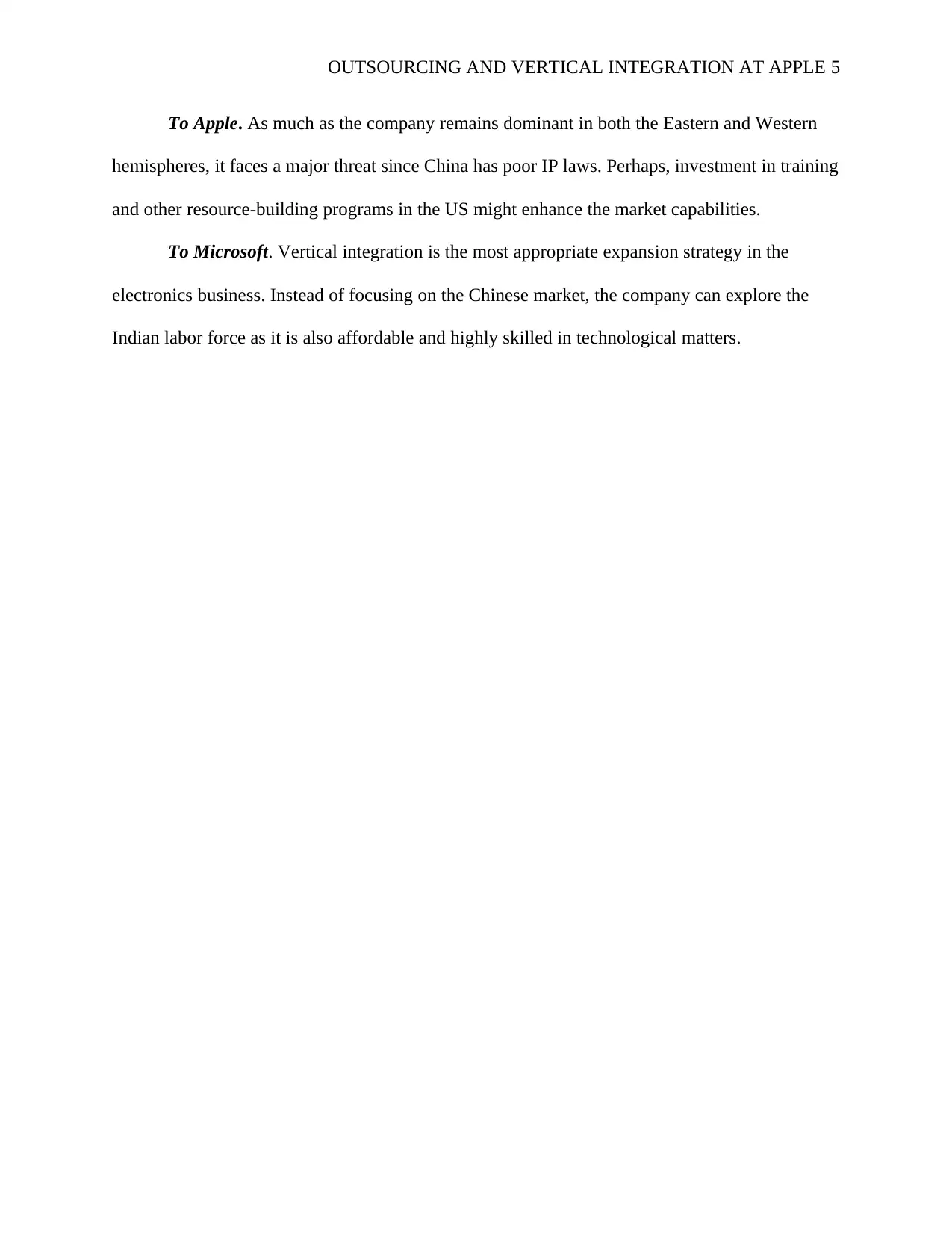
OUTSOURCING AND VERTICAL INTEGRATION AT APPLE 5
To Apple. As much as the company remains dominant in both the Eastern and Western
hemispheres, it faces a major threat since China has poor IP laws. Perhaps, investment in training
and other resource-building programs in the US might enhance the market capabilities.
To Microsoft. Vertical integration is the most appropriate expansion strategy in the
electronics business. Instead of focusing on the Chinese market, the company can explore the
Indian labor force as it is also affordable and highly skilled in technological matters.
To Apple. As much as the company remains dominant in both the Eastern and Western
hemispheres, it faces a major threat since China has poor IP laws. Perhaps, investment in training
and other resource-building programs in the US might enhance the market capabilities.
To Microsoft. Vertical integration is the most appropriate expansion strategy in the
electronics business. Instead of focusing on the Chinese market, the company can explore the
Indian labor force as it is also affordable and highly skilled in technological matters.
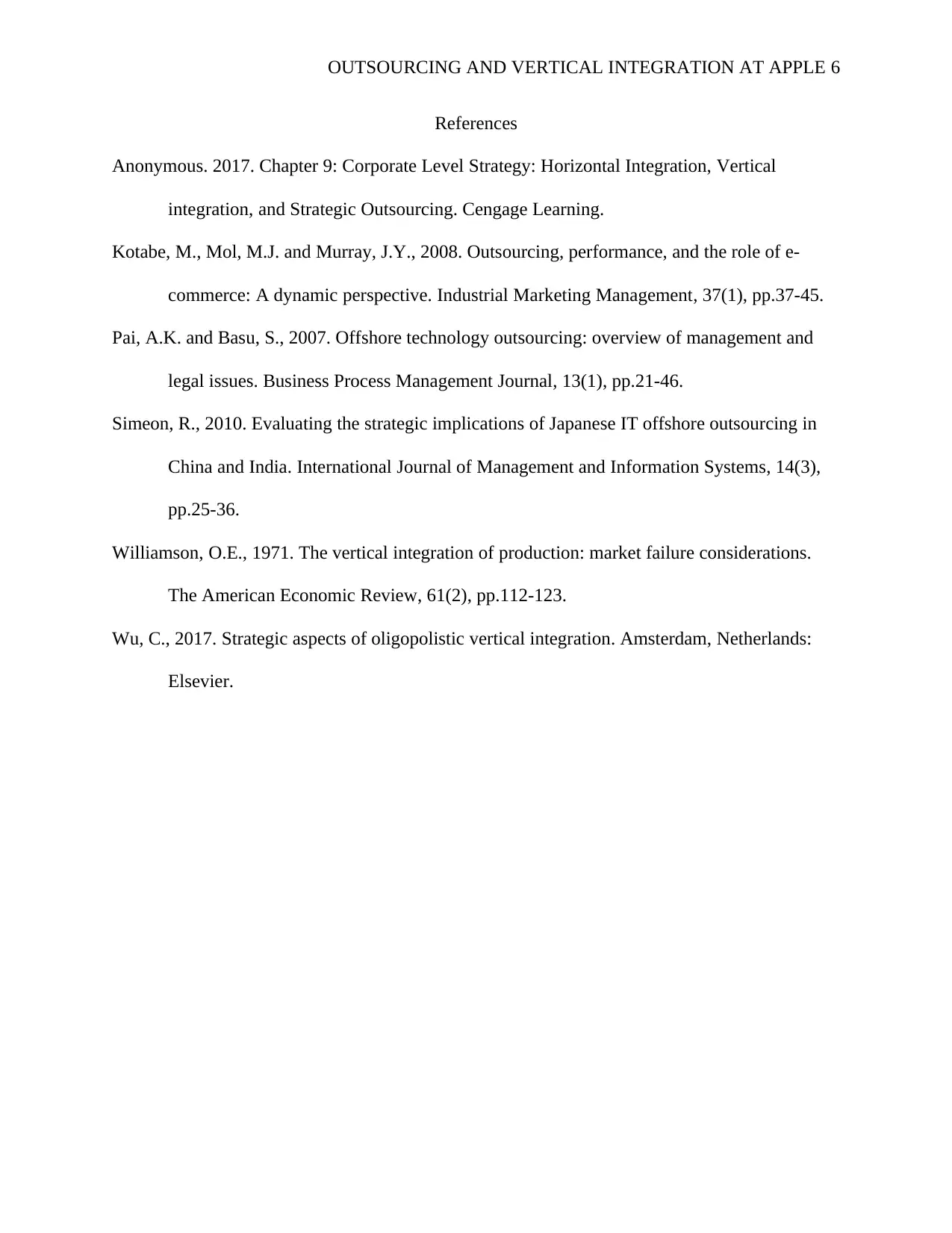
OUTSOURCING AND VERTICAL INTEGRATION AT APPLE 6
References
Anonymous. 2017. Chapter 9: Corporate Level Strategy: Horizontal Integration, Vertical
integration, and Strategic Outsourcing. Cengage Learning.
Kotabe, M., Mol, M.J. and Murray, J.Y., 2008. Outsourcing, performance, and the role of e-
commerce: A dynamic perspective. Industrial Marketing Management, 37(1), pp.37-45.
Pai, A.K. and Basu, S., 2007. Offshore technology outsourcing: overview of management and
legal issues. Business Process Management Journal, 13(1), pp.21-46.
Simeon, R., 2010. Evaluating the strategic implications of Japanese IT offshore outsourcing in
China and India. International Journal of Management and Information Systems, 14(3),
pp.25-36.
Williamson, O.E., 1971. The vertical integration of production: market failure considerations.
The American Economic Review, 61(2), pp.112-123.
Wu, C., 2017. Strategic aspects of oligopolistic vertical integration. Amsterdam, Netherlands:
Elsevier.
References
Anonymous. 2017. Chapter 9: Corporate Level Strategy: Horizontal Integration, Vertical
integration, and Strategic Outsourcing. Cengage Learning.
Kotabe, M., Mol, M.J. and Murray, J.Y., 2008. Outsourcing, performance, and the role of e-
commerce: A dynamic perspective. Industrial Marketing Management, 37(1), pp.37-45.
Pai, A.K. and Basu, S., 2007. Offshore technology outsourcing: overview of management and
legal issues. Business Process Management Journal, 13(1), pp.21-46.
Simeon, R., 2010. Evaluating the strategic implications of Japanese IT offshore outsourcing in
China and India. International Journal of Management and Information Systems, 14(3),
pp.25-36.
Williamson, O.E., 1971. The vertical integration of production: market failure considerations.
The American Economic Review, 61(2), pp.112-123.
Wu, C., 2017. Strategic aspects of oligopolistic vertical integration. Amsterdam, Netherlands:
Elsevier.
⊘ This is a preview!⊘
Do you want full access?
Subscribe today to unlock all pages.

Trusted by 1+ million students worldwide
1 out of 6
Related Documents
Your All-in-One AI-Powered Toolkit for Academic Success.
+13062052269
info@desklib.com
Available 24*7 on WhatsApp / Email
![[object Object]](/_next/static/media/star-bottom.7253800d.svg)
Unlock your academic potential
Copyright © 2020–2025 A2Z Services. All Rights Reserved. Developed and managed by ZUCOL.




